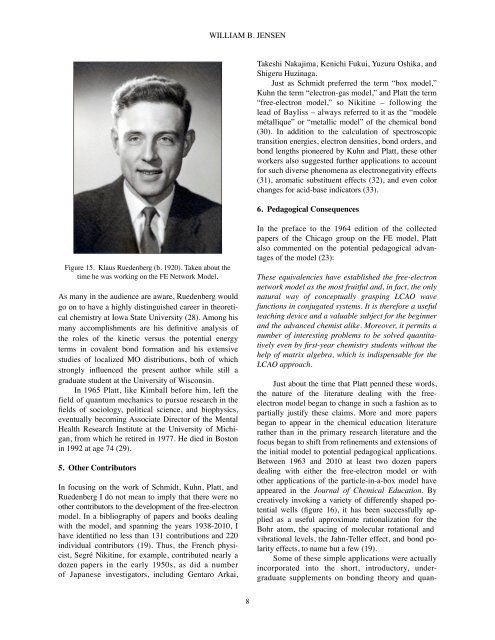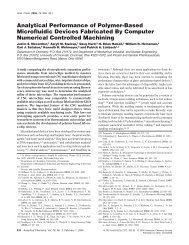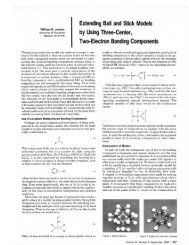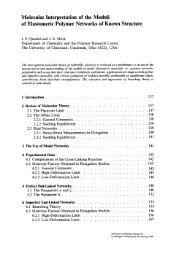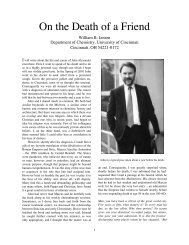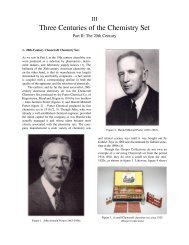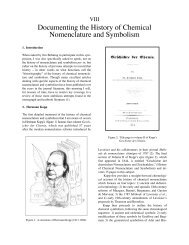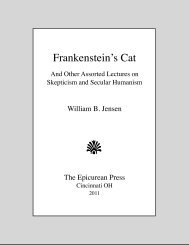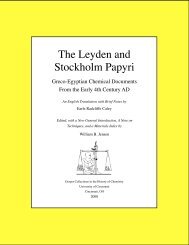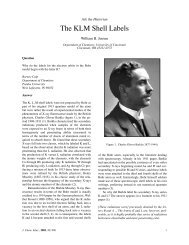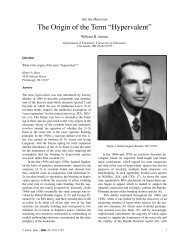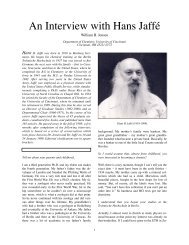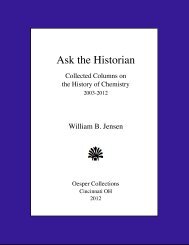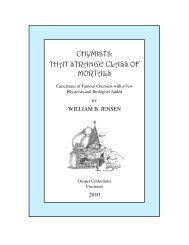198. Free Electron.pdf - University of Cincinnati
198. Free Electron.pdf - University of Cincinnati
198. Free Electron.pdf - University of Cincinnati
Create successful ePaper yourself
Turn your PDF publications into a flip-book with our unique Google optimized e-Paper software.
WILLIAM B. JENSEN<br />
Takeshi Nakajima, Kenichi Fukui, Yuzuru Oshika, and<br />
Shigeru Huzinaga.<br />
Just as Schmidt preferred the term “box model,”<br />
Kuhn the term “electron-gas model,” and Platt the term<br />
“free-electron model,” so Nikitine – following the<br />
lead <strong>of</strong> Bayliss – always referred to it as the “modèle<br />
métallique” or “metallic model” <strong>of</strong> the chemical bond<br />
(30). In addition to the calculation <strong>of</strong> spectroscopic<br />
transition energies, electron densities, bond orders, and<br />
bond lengths pioneered by Kuhn and Platt, these other<br />
workers also suggested further applications to account<br />
for such diverse phenomena as electronegativity effects<br />
(31), aromatic substituent effects (32), and even color<br />
changes for acid-base indicators (33).<br />
6. Pedagogical Consequences<br />
Figure 15. Klaus Ruedenberg (b. 1920). Taken about the<br />
time he was working on the FE Network Model.<br />
As many in the audience are aware, Ruedenberg would<br />
go on to have a highly distinguished career in theoretical<br />
chemistry at Iowa State <strong>University</strong> (28). Among his<br />
many accomplishments are his definitive analysis <strong>of</strong><br />
the roles <strong>of</strong> the kinetic versus the potential energy<br />
terms in covalent bond formation and his extensive<br />
studies <strong>of</strong> localized MO distributions, both <strong>of</strong> which<br />
strongly influenced the present author while still a<br />
graduate student at the <strong>University</strong> <strong>of</strong> Wisconsin.<br />
In 1965 Platt, like Kimball before him, left the<br />
field <strong>of</strong> quantum mechanics to pursue research in the<br />
fields <strong>of</strong> sociology, political science, and biophysics,<br />
eventually becoming Associate Director <strong>of</strong> the Mental<br />
Health Research Institute at the <strong>University</strong> <strong>of</strong> Michigan,<br />
from which he retired in 1977. He died in Boston<br />
in 1992 at age 74 (29).<br />
5. Other Contributors <br />
In focusing on the work <strong>of</strong> Schmidt, Kuhn, Platt, and<br />
Ruedenberg I do not mean to imply that there were no<br />
other contributors to the development <strong>of</strong> the free-electron<br />
model. In a bibliography <strong>of</strong> papers and books dealing<br />
with the model, and spanning the years 1938-2010, I<br />
have identified no less than 131 contributions and 220<br />
individual contributors (19). Thus, the French physicist,<br />
Segré Nikitine, for example, contributed nearly a<br />
dozen papers in the early 1950s, as did a number<br />
<strong>of</strong> Japanese investigators, including Gentaro Arkai,<br />
In the preface to the 1964 edition <strong>of</strong> the collected<br />
papers <strong>of</strong> the Chicago group on the FE model, Platt<br />
also commented on the potential pedagogical advantages<br />
<strong>of</strong> the model (23):<br />
These equivalencies have established the free-electron<br />
network model as the most fruitful and, in fact, the only<br />
natural way <strong>of</strong> conceptually grasping LCAO wave<br />
functions in conjugated systems. It is therefore a useful<br />
teaching device and a valuable subject for the beginner<br />
and the advanced chemist alike. Moreover, it permits a<br />
number <strong>of</strong> interesting problems to be solved quantitatively<br />
even by first-year chemistry students without the<br />
help <strong>of</strong> matrix algebra, which is indispensable for the<br />
LCAO approach.<br />
Just about the time that Platt penned these words,<br />
the nature <strong>of</strong> the literature dealing with the freeelectron<br />
model began to change in such a fashion as to<br />
partially justify these claims. More and more papers<br />
began to appear in the chemical education literature<br />
rather than in the primary research literature and the<br />
focus began to shift from refinements and extensions <strong>of</strong><br />
the initial model to potential pedagogical applications.<br />
Between 1963 and 2010 at least two dozen papers<br />
dealing with either the free-electron model or with<br />
other applications <strong>of</strong> the particle-in-a-box model have<br />
appeared in the Journal <strong>of</strong> Chemical Education. By<br />
creatively invoking a variety <strong>of</strong> differently shaped potential<br />
wells (figure 16), it has been successfully applied<br />
as a useful approximate rationalization for the<br />
Bohr atom, the spacing <strong>of</strong> molecular rotational and<br />
vibrational levels, the Jahn-Teller effect, and bond polarity<br />
effects, to name but a few (19).<br />
Some <strong>of</strong> these simple applications were actually<br />
incorporated into the short, introductory, undergraduate<br />
supplements on bonding theory and quan-<br />
8


